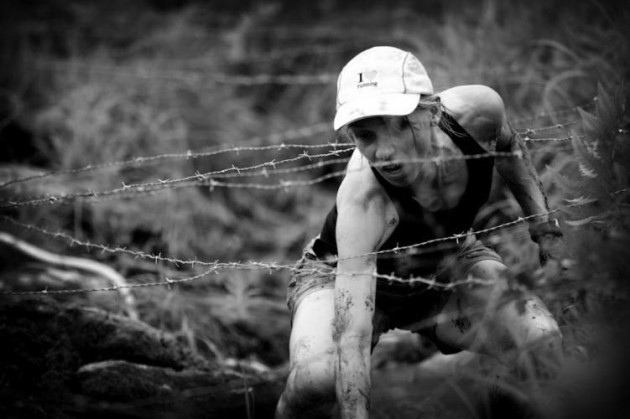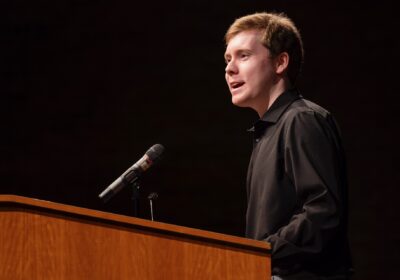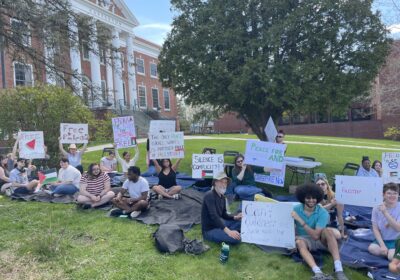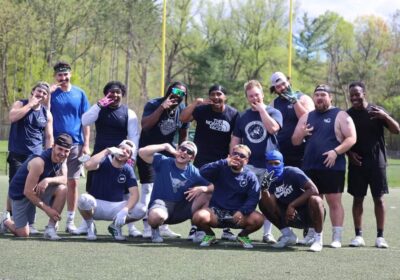You won’t finish

Imagine that you have just signed up for an endurance race. One called the Death Race, none –the-less. The two race directors inform you six months prior to the race that you are required to bring a mountain bike the day of. So, assuming that you will be riding the bike during the race, of course you train. However, when you arrive at the race site, they remove the bike tires and duct tape them together and take the bike’s chain and place it in a sealed plastic bag: you are to carry the body of the bike for the entirety of the race.
Oh, and during the race you discover that one obstacle is to locate the chain with your name on it, which is at the bottom of a pond with 200 other chains.
And the bike tires? They are scattered around and in various trees in the deep forests of Pittsfield, Vermont.
Not to mention it’s pitch black and you have been up for 26 hours tackling physically and mentally demanding tasks.
The bikes are only actually ridden for about 45 seconds at the end of the race.
This is only one example of the tasks that are required of participants in the Spartan Death Race, which has been held in Pittsfield for the past six years in the month of June.
Professor Andy Weinberg, who was only hired at Castleton as full-time this fall, is one of two co-founders of the race which, as described by its website www.youmaydie.com, is a “grueling, 24 hour endurance race comprised of mud runs, obstacle racing, trail racing, physical challenges and mental challenges all in a +48 hour adventure race.”
“I know the website is called youmaydie.com, but we obviously don’t really want people to die…however we have had some serious injuries,” said Weinberg.
After completing years of marathons, triathlons and swimming events, along with his friend and co-founder Joe DeSena, they decided that they needed to create something a little more exciting.
“The races…they became sort of boring. You know, marathons are always 26 miles, for example, so you know when they start, you know when they finish- you basically know everything that is going to happen. So we thought it would be cool to come up with something people don’t know, something that nobody could duplicate,” Weinberg said. “This race is unlike any other… it is meant to break you. In every other race people cheer for you, but in the death race we don’t… instead we tell you that you are not going to finish.”
Weinberg, who taught as both a High School P.E teacher in Illinois for 15 years and as a high school teacher at Middlebury prior to coming to Castleton, said that he considers himself to be a lifetime athlete, however teaching is his full-time profession and working with the Race is more of his hobby.
The idea for the Death Race evolved one day after Weinberg and DeSena were asked to split wood for one of their neighbors. The two competitors decided to take it to the next level and of course, made it into a competition to see who could chop the most wood.
“If you chop wood for an hour, I mean, it’s tough. I was so sore the next day I could barely move—I couldn’t even brush my teeth,” he said.
So they decided to do something with it.
“The first year we sort of winged it. It was just ten of us who took 24 hours to finish the race and then we took it from there, working on it all the time,” he said.
In summer of 2012 Pittsfield will hold its 7th annual death race, although competitors can never really be sure when it will actually start.
Professor Matt Soroka, who participated in the race two years ago, explained that one of the biggest things with the race is the unknown. “The two race directors, they tell you two completely different things- they even lie about when it’s supposed to start,” said Soroka.
During Soroka’s race they were told to bring a 30 lb. bag of pennies to the start. When they arrived at the start, the directors told them they could leave the pennies behind if they chose to.
“None of us did it though, because we thought we would need it… it turned out they were really donating them to charity,” said Soroka.
The race costs $400 to enter and used to feature a cash prize, but Weinberg said that out of all the years that they offered the prize, only one person accepted it.
The rest donated it to charity. A majority of the money raised at the race is donated to the Wounded Warrior Project, a diabetes fund, and locally to both the food and women’s shelter.
Although Soroka did not end up finishing the race, he did last 26 hours and said that he was not disappointed by his efforts.
“Because it was my first year, I was more relieved than disappointed. At that point I was mostly worried about my wife who was 11 months pregnant,” he explained.
“The race is nice, but it reaches a point where you realize that you have stuff to do the next day,” he said.
Soroka is already signed up for the 2012 Death Race, however, and said that he will probably not bring his family along this time around.
According to Weinberg, while only 20% of 200 participants finish the race, there are people from “all walks of life” who attend: males, females, people of all ages (the youngest person to complete the race was 17 and the oldest was 54) and that last year 32 states were represented.
“There are doctors, teachers, military personnel… these people are truly inspirational,” said Weinberg.
He also noted that the Death Race is not the only race that is offered through the organization (Peak Racing), and that if you access the website you will find a variety of different races designated for a variety of different types of people: their main goal is to just get people active.
“We are both life-long athletes and we believe that fitness is important in life,” said Weinberg while addressing the problems of obesity and diabetes in our country, “so we designed something unique and different…something that gets people of this couch,” he said.







